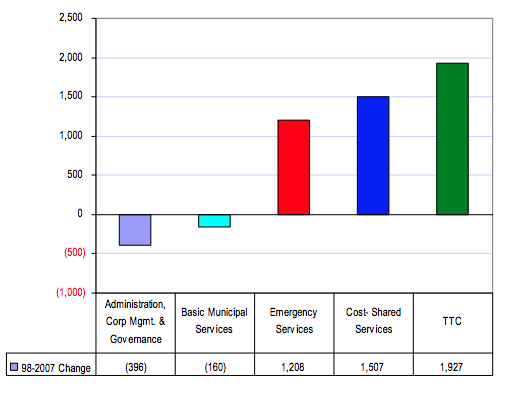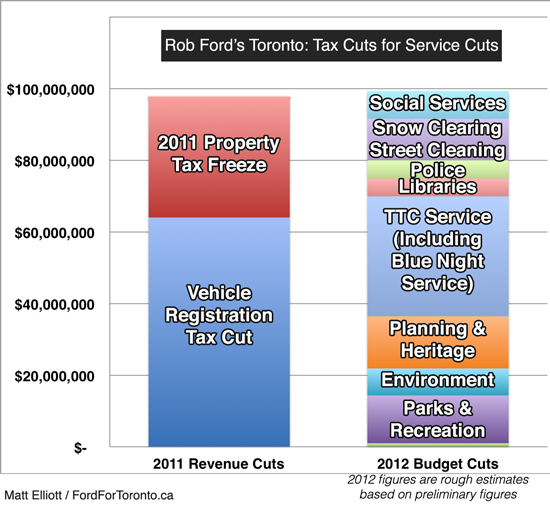There will be blood. And also layoffs.
That’s the word from City Manager Joe Pennachetti, who has to be loving his life these days, and from the mayor and his assorted hangers-on. The strategy seems to be to pretend that layoffs were always on the table — of course they were! –, even though Rob Ford himself promised there was “no need for layoffs” during his campaign.
The National Post’s Natalie Alcoba covers the story:
Pink slips are on the way for city employees, the municipality’s top bureaucrat warned on Thursday, as officials feverishly put numbers together to see what it takes to balance the budget next year.
“There will be layoffs and that’s been known for a long time,†city manager Joe Pennachetti told reporters as the budget committee deliberated on garbage and water rates.
…
Budget Chief Mike Del Grande would not say whether he is expecting layoffs to be part of the financial mix.
“We’re feverishly putting numbers together to see what it takes to balance the budget,†he said. He pointed out that the city’s labour force has ballooned since amalgamation, when the whole idea was to reduce employees and be more efficient.
via ‘There will be layoffs,’ city manager warns | National Post. (Emphasis added.)
That last bit is a familiar refrain at this point. And it’s the sort of thing that people assume is true, even without evidence. Of course our big government socialist bureaucracy would never get any smaller, what with all the chipmunk suits and confusing public art they keep spending our tax money on.
But, hold on, once we get past the rhetoric and the ideology, we’re still left with the fundamental question: is it true? Did the number of city staff only increase after amalgamation?
Looking to the numbers
Between 1998 and 2007 — the last year I could find numbers for — the following City departments actually saw a net reduction in staff:
- Clerk’s Office (-97 positions)
- HR (-73)
- Finance (-69)
- Mayor & Council Offices (-51)
- Facilities (-42)
- Fleet (-30)
- Public Info & Creative Services (-28)
- Auditor General’s Office (-24)
- City Manager (-13)
- Something called CS-SII (-9)
- Legal (-4)
- Toronto Water (-432)
- Public Library (-194)
- Transportation (-122)
- Housing (-107)
- Public Works (-53)
- Solid Waste (-49)
- Business Support (-41)
- Policy, Finance & Admin (-14)
- Economic Development/Culture/Tourism(-11)
- Parking Authority (-6)
- Fire (-7)
On the other hand, here’s where the city added employees:
- IT (+44 Positions)
- Planning (+5)
- Waterfront/Clean & Beautiful City (+8)
- Other/ABCs (+15)
- Zoo (+20)
- Municipal Licensing & Standards (+21)
- Building (+30)
- 311 (+33)
- Parking Enforcement (+54)
- Works – Technical Services (+83)
- Exhibition Place (+164)
- Parks, Forest & Recreation (+186)
- Court Services (+251)
- EMS (+340)
- Police (+875)
- Social Development (+30)
- Homes for Aged (+111)
- Child Services (+114)
- Social Services (+195)
- Shelter & Housing (+353)
- Public Health (+704)
- TTC (+1,927)
Whew. So what do we learn from all that? This chart from the City’s 2008 Operating Budget Presentation sums things up pretty well:
 (There’s also this more detailed chart if you’re so inclined.)
(There’s also this more detailed chart if you’re so inclined.)
Post-amalgamation, the city actually shed staff positions in the places where you’d think they would. The number of people doing administrative duties decreased as departments were combined and services shared. Basic municipal services — things like economic development, solid waste, etc — saw either similar reductions or limited growth, with a few exceptions.
Where there was growth, it was either because of the times we live in (increases to the number of IT staff, for example) or because council decided to put emphasis on specific departments or services  in order to grow or improve the city. If a mayor decides that he or she wants to improve the cleanliness of the city, as David Miller did with his Clean & Beautiful City initiative, you probably need to put some staff on it.
Some of the biggest increases in places where the city has limited ability to control costs. Social Development, Homes for Aged, Child Services, Social Services, Shelter & Housing and Public Health are all cost-shared services with the provincial government. Like we saw earlier this year with the vanishing-and-reappearing public health nurses, often the province will provide fully funded positions to municipalities. They also mandate minimum service levels, tying the city’s hands. (To be fair, they also transfer money to the city to cover — or partially cover — the delivery of these programs.)
The big spikes, of course, came from the Police (and EMS) and the TTC. As Rob Ford just learned, the police budget is challenging to rein in. To say the least.
The TTC growth is even easier to explain. Over the last seven years, TTC service was expanded far beyond the dismal levels of the mid 90s. And people noticed, as ridership has increased to record highs. But with transit, the staffing equation is simple: if you add a bus, you add a driver. And with more drivers comes more supervisors, more mechanics and more support staff.
So-called ‘efficiencies’ will only get you so far with transit, unless you start putting Total Recall-esque Johnny Cabs in the driver’s seat of city buses and streetcars. The only way to significantly cut staff here is to cut service.
Layoffs almost always mean service cuts
With a well-executed plan for continuous improvement, any corporation — including the City of Toronto — can start doing more with less. Toronto has, in fact, been doing this for years. Each of the city’s last six approved budgets included significant savings from efficiencies. With continuous improvement and employee attrition, you’re able to successfully shrink the size of government without layoffs and buy-outs.
But Rob Ford’s government has blown away any notion of continuous improvement, instead opting to look at the budget — and the city’s workforce — with a hatchet in hand. A look at where the city has seen staffing growth over the last decade makes it clear: any layoffs will almost certainly mean a roll-back in services.
